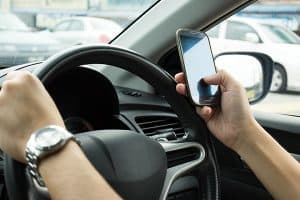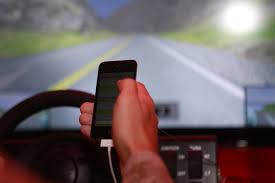 In an effort to curb the texting-and-driving accidents that are threatening motorists today, Illinois recently approved a law that imposes stiffer penalties for any driver pulled over because of texting.
In an effort to curb the texting-and-driving accidents that are threatening motorists today, Illinois recently approved a law that imposes stiffer penalties for any driver pulled over because of texting.
“One Short Text Can Cost Lives”
HB 4846, signed into law by Gov. Bruce Rauner on August 14, would take effect starting July 1, 2019. The law would mandate that motorists be issued a moving violation that would go on their driving records if they are caught texting and driving.
This is notably harsher than the previous texting-and-driving law, which took effect in 2014. Under that law, texting drivers would only have been issued nonmoving violations for first offenses, which would not have impacted their driving records. Notably, three moving violations within 12 months could result in the suspension of a drivers’ license.
Additionally, a motorist caught texting and driving would face a $75 fine for the first offense, on top of the moving violation. The second offense would result in a $100 fine, the third a $125 fine, and the fourth a $150 fine – with each instance being noted on a motorist’s driving record.
“Sending one quick text while driving is dangerous,” said Sen. Cristina Castro, the Elgin Democrat who sponsored HB 4846. “We have to work together to get the message across that texting and driving is one of the most dangerous forms of distracted driving. One short text can cost lives.”
Texting-and-Driving Accidents on the Rise
Texting has become commonplace in America today. In fact, according to a recent Gallup poll, sending and receiving text messages has become the most prevalent form of communication for Americans younger than 50, with an average of 32 texts per American per day. With texting such a regular part of American life, we engage in the activity in virtually every setting: at work, at home, during meals and leisure time, and – most calamitously – while driving. As the rate of texting and driving has risen, texting-and-driving accidents have begun making up a significant percentage of traffic crashes.
Sending texts while driving, even short ones, can be extremely reckless because it distracts a driver’s attention from the main task at hand. For example, at 60 miles per hour, a motor vehicle travels 88 feet per second. If you take four seconds to dash off a text message while you are driving, you will travel nearly the length of a football field without your eyes on the road – placing everyone in your path, and in your vehicle, in grave danger.
While any activity that distracts a driver’s attention – such as adjusting the radio, eating, or looking at billboards – is risky, texting is perhaps the most dangerous because it involves all three types of driver distraction. Texting and driving:
- Takes the driver’s hands off of the steering wheel;
- Takes the driver’s eyes off of the road; and
- Takes the driver’s mind off of driving.
With such a high level of distraction in play, it is no wonder why texting and driving is so hazardous. In fact, the Illinois Department of Transportation alleges that driving and texting is four times more dangerous than driving while intoxicated. And what is more disturbing, texting-and-driving accidents seem to be on the rise.
According to a recent study by Allstate Insurance, nearly half of all drivers polled admitted to texting and driving. Another study by Cambridge Mobile Telematics found that nearly a quarter of drivers were using cell phones within a minute before their crashes occurred, suggesting that a significant percentage of these crashes could be classified as texting-and-driving accidents.
These findings mirror statistics from the National Highway Traffic Safety Administration (NHTSA) about distracted driving, cell phone use, and texting-and-driving accidents. The NHTSA estimates that at least 25 percent of police-reported crashes involve distracted driving. According to the NHSTA, distracted driving most commonly results from cell phone use, while texting is the common cell phone activity. Based on the above statistics, it stands to reason that a large portion of these crashes are texting-and-driving accidents.
Reckless Choices, Deadly Consequences
The rising tide of texting-and-driving accidents is not only dangerous but deadly. The NHTSA estimates that distraction – with cell phone use being the most common cause – was a factor in roughly 10 percent of all fatal motor vehicle crashes and 18 percent of all crashes causing injury.
According to a study released by Bloomberg in 2017, the number of fatal car crashes has risen 14 percent since 2015. While drivers are often hesitant to admit that they were using a cell phone while driving, given that the rates of drinking and driving have been falling and the rates of seatbelt use have been rising over time, the trends would suggest that cell phone use – and texting – while driving has played a significant role in the increase in vehicular fatalities.
While this newly passed legislation could be a positive next step in encouraging Illinoisans to think twice before texting behind the wheel, the rate of texting-and-driving accidents may continue to go up before it goes down.
Chicago Texting-and-Driving Accident Lawyers
With texting-and-driving accidents becoming more commonplace, Illinois drivers are at greater risk of bodily harm. If you have been seriously injured in an auto accident because of a negligent driver, consider enlisting the help of an experienced, knowledgeable lawyer to help you obtain the financial compensation, and the justice, that you deserve, such as the Chicago texting-and-driving accident lawyers at GWC Injury Lawyers.
GWC is Illinois’ largest Personal Injury and Workers’ Compensation law firm. We have offices throughout the state and have recovered over $2 billion for our clients.
To schedule a no-cost, no-obligation consultation with one of our attorneys, please contact GWC at any time. Call us (312) 464-1234 or click here to chat with one of our representatives.
<< BACK TO BLOG POSTS